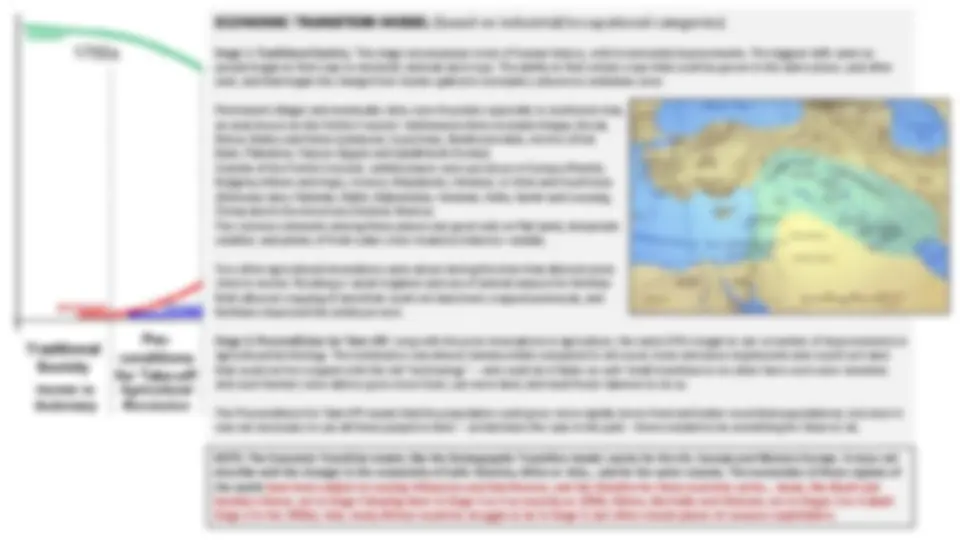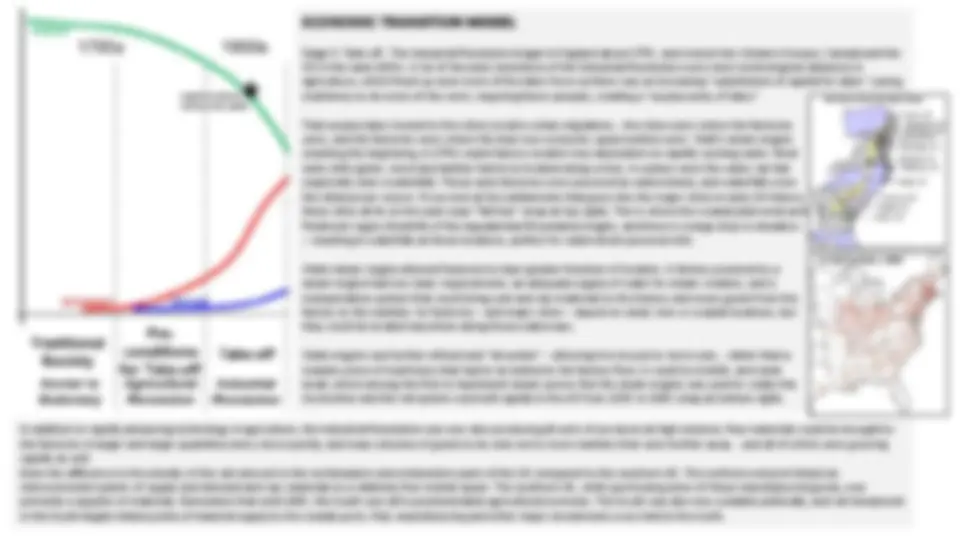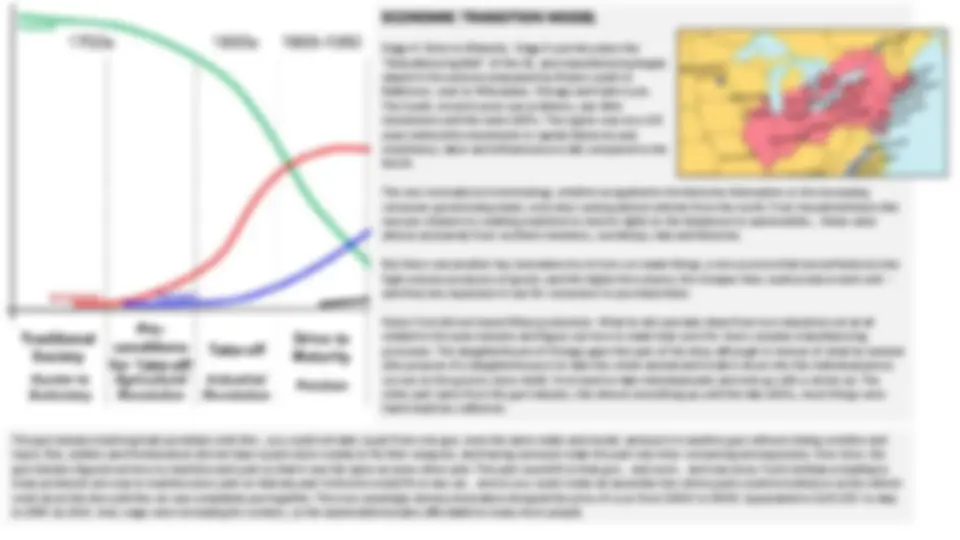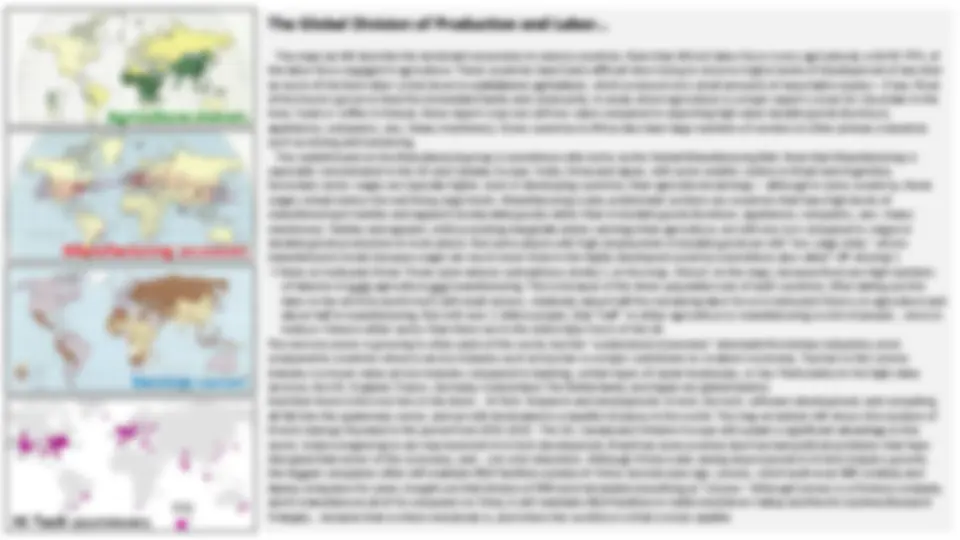






Study with the several resources on Docsity

Earn points by helping other students or get them with a premium plan


Prepare for your exams
Study with the several resources on Docsity

Earn points to download
Earn points by helping other students or get them with a premium plan
Community
Ask the community for help and clear up your study doubts
Discover the best universities in your country according to Docsity users
Free resources
Download our free guides on studying techniques, anxiety management strategies, and thesis advice from Docsity tutors
In Rostow's original model, there was no Stage 6, but by 1971, he proposed a Stage 6 as “The Search for Quality.” The idea of this was that society would move ...
Typology: Lecture notes
1 / 8

This page cannot be seen from the preview
Don't miss anything!





sectors – different types of businesses and occupations. Primary : “extractive” – farming, forestry, fishing, mining … these industries gather the resources we need to make other things, extracting raw materials that will then be used to make other goods. The partial exception to this is agriculture; we do eat food that has been harvested and is otherwise untouched until we cook it, often combining it with other foods and spices. In this case, we are the “manufacturers” – a weird bit of logic that was used to classify companies like MacDonalds as a “manufacturer” rather than a service industry! Secondary : “transformation, value-added” – construction, manufacturing …these industries take the resources that were gathered up by the Primary sector businesses and then are transformed into something more useful to us, which adds value to those materials. Three examples: (1) home builders bring together all of the bits and pieces that are needed to build a house (many of those “parts” manufactured by another company, which is called an “intermediate supplier”). Any of us could, if we really wanted to, build a house. But it is easier to pay the value-added by the construction company to have them do it for us. (2) Automobiles… a little more far-fetched, though it is possible to build your own car out of parts supplied by other manufacturers, it is certainly far more difficult to do than building a house. A car is basically a tool we use to move around faster than walking or using a horse, and having someone else make one for you is easier than doing it yourself (and, cheaper). (3) Apparel. At the opposite end of the difficulty spectrum, clothing is relatively easy to make create for anyone willing to learn (though I personally cannot successfully sew a button on, despite many attempts to learn how to do that). And fabric is often inexpensive… it is possible to “manufacture” your own clothing if you are willing to trade off the retail value-added for some level of time expense. But as evidenced by the shrinking number of sewing machine manufacturers (there are less than 30 in the world; at one time there were almost 250 sewing machine manufacturers in the US alone). Very, very few people make their own clothes any more. Tertiary : “services” – banking, transportation, wholesale, retail, K-12 education …service industries sell us something that is “intangible” – not something that you can see and hold and have sitting on a shelf at home (or in your driveway). K-12 Education is a service. Eating at a restaurant is a service (yes, you can actually hold the food, and as noted before, some percentage of labor in the restaurant industry is considered manufacturing)… but you are paying for the wait staff, the ambiance, and someone to clean up after you. Walt Disney World is a service – a vacation, fun, relaxation… none of which will be anything but memories after you leave. Banks are a service (you can hold money in your hand but the banks don’t make it, they just pass it back and forth between the mint, you and everyone you owe money to). Banks are also a good example of a service industry that provides different kinds of services: personal (your checking and savings accounts, credit cards, auto and home loans…) and producer services (those offices in the back you never go to that provide loans for construction companies to build houses until you pay them through the mortgage the bank gave you), funds to stock up on inventory (like at Christmas time), funds to expand the business (either selling to new markets or physically enlarging the building they are in). The above three – primary, secondary and tertiary – sectors are how we classified the bits and pieces of our economy for many years. But in the 1960s, something new, and different from the old sectors, came along. The industries and occupations could have been classified in the old scheme, but the rapidly expansion of industries and occupations in this new thing, and the very different nature of some of the businesses and jobs led us to create an entirely new category: Quaternary : “technology & information” – consulting, biotechnology, research & development, higher education, software development … the quaternary sector is sometimes referred to as the ‘knowledge industry” or the “information economy. Research and Development (R&D) are a big part of it, but so too now is high-level computer programming – the kind of programming that makes computers (usually) do what we want and expect them to do, whether it’s a phone or a laptop or a car or an industrial machine like a robotic welder. “Consultant” seems like a vague occupation and some would argue that this should be a service occupation… but consider what it is that a consultant sells. Information. A company hires a consultant because it wants to make some sort of change but does not have the expertise itself to know how to do that, so they hire a consultant to find out how to do it without making a lot of mistakes and wasting a lot of money (assuming they hired a good consultant). The quaternary sector is both the fastest growing and most problematic sector of the economy in the US today.
Stage 3: Take-off. The Industrial Revolution began in England about 1750, and moved into Western Europe, Canada and the US in the early 1800s. A lot of the early inventions of the Industrial Revolution were more technological advances in agriculture, which freed up even more of the labor force as there was an increasing “substitution of capital for labor” (using machinery to do more of the work, requiring fewer people), creating a “surplus army of labor.” That surplus labor moved to the cities (rural to urban migration)… the cities were where the factories were, and the factories were where the best new economic opportunities were. Watt’s steam engine (marking the beginning, in 1750) made factory location less dependent on rapidly running water. Most early mills (grain, wood and textile) had to be located along a river, in a place were the water ran fast (especially near a waterfall). Those early factories were powered by waterwheels, and waterfalls were the ideal power source. If you look at the settlements that grew into the major cities in early US history, these cities all lie on the east coast “fall line” (map at top right). This is where the coastal plain ends and the Piedmont region (foothills of the Appalachian Mountains) begins, and there is a large drop in elevation
Stage 4: Drive to Maturity. Stage 3 put into place the “Manufacturing Belt” of the US, and manufacturing largely stayed in the area encompassed by Boston south to Baltimore, west to Milwaukee, Chicago and Saint Louis. The South, mired in post-war problems, saw little investment until the early 1900s. The region was now 100 years behind the investment in capital (factories and machinery), labor and infrastructure (rail) compared to the North. The new innovations in technology, whether as applied to the factories themselves or the increasing consumer goods being made, were also coming almost entirely from the north. From household items like vacuum cleaners to washing machines to electric lights to the telephone to automobiles… these came almost exclusively from northern inventors, workshops, labs and factories. But there was another key innovation too in how we made things, a new process that turned factories into high-volume producers of goods, and the higher the volume, the cheaper they could produce each unit – and they less expensive it was for consumers to purchase them. Henry Ford did not invent Mass production. What he did was take ideas from two industries not at all related to the auto industry and figure out how to make that work for more complex manufacturing processes. The slaughterhouse of Chicago gave him part of the idea, although in reverse of what he needed (the purpose of a slaughterhouse is to take the whole animal and break it down into the individual pieces we see on the grocery store shelf). Ford need to take individual parts and end up with a whole car. The other part came from the gun industry. Like almost everything up until the late 1800s, most things were hand-made by craftsmen. The gun industry had long had a problem with this… you could not take a part from one gun, even the same make and model, and put it in another gun without risking a misfire and injury. But, soldiers and frontiersmen did not have a parts store nearby to fix their weapons, and having someone make the part was time-consuming and expensive. Over time, the gun industry figured out how to machine each part so that it was the same as every other part. This part would fit in that gun… and work… and visa versa. Ford’s brilliance leading to mass produced cars was to machine every part so that any part in the bin would fit on any car… and so you could create an assembly line where parts could be bolted on as the vehicle went down the line until the car was completely put together. This now seemingly obvious innovation dropped the price of a car from $3000 to $5000 (equivalent to $100,000 to day) to $495 by 1914. And, wage were increasing for workers, so the automobile became affordable to many more people. PRIMARY SECONDARY TERTIARY
ENIAC (1946) Electronic Numerical Integrator and Computer … 70 years, from ENIAC to the Samsung Note 20… The specs shown are to many of us so much blah, blah, blah. Think about this: In addition to having a display, color, lots of memory, and weighs 0.0008% of an ENIAC, the Samsung smartphone is approximately 24 million times more powerful than that first digital computer. Stage 6 …?... In Rostow’s original model, there was no Stage 6, but by 1971, he proposed a Stage 6 as “The Search for Quality.” The idea of this was that society would move towards something “beyond consumption.” Families would become larger (family size began to shrink rapidly in the early 1960s); consumer products would become more durable; benefits, such as more vacation time, would be more important than increased income; and economic security would be normal. Family size has not gotten larger… 3.1 today, down from 3.7 in the 1960s. Consumer products are more durable to an extent, but they are also more disposable. We do value benefits, but many Americans have fewer benefits than they did 10-15 years ago after some increases from the 1950s to the 1970s. And even before the Covid-19 pandemic, economic security was becoming an increasing problem for many. Alternatively, one could look at the economic restructuring that has occurred in the last 40+ years, sometimes referred to as the Quantitative or Information Revolution that has created the Knowledge Economy. Computers and related technologies have markedly changed what kinds of things we can do, and how we do many things. The Tertiary sector has seen some leveling off, even though it is still the largest sector of employment. The Secondary sector has continued to shrink… but, the contribution of the Secondary sector to the US economy is as big as it was in the 1960s (when the Secondary sector labor force was the largest segment of the US economy). The problem for that surplus army of labor that has been created out of the Secondary sector is that it is not easy to move into the equally high-paying in the Quaternary sector, which has very high skill and education requirements. Instead, they tend to move downward, into lower-paying and often less secure in the Tertiary sector. This is one factor in the stagnating incomes of the American middle class, and increasing economic insecurity. How much of a power in the economy are computers and high technology? The far top left photo is only a partial image of ENIAC, the first digital computer. #2 is the first IBM mainframe. #3, the first IBM PC, the first desktop computer. #4, the first laptop… and 5, a current smartphone. The difference in power from generation to generation of computers is staggering. Clarke’s remarks in Pop Science (inset, top)? A smartphone can do ALL of this.
12 Gigabytes RAM 512 Gigabytes internal memory Up to 1 Terabyte external storage (microSD card) 6.49 x 3.04 x 0.32 inches; 7.34 ounces $ 5.00 kIPS (1,000 Instructions Per Second) CPU 1 Megahertz w/ Single Core No graphics capability, no video, no color (b/w print out only) No camera No sound output System memory equivalent to 20 words No external memory storage 50’ long x 30 feet wide; 30 tons $8 million Samsung Note 20 Ultra 122.38 GFLOPS (1 billion Instructions Per Second) CPU 3.1 Gigahertz w/ Octa (8) Core Color graphics/video, color printing 3 cameras (rear); 1 camera (front) Dolby stereo sound output PRIMARY SECONDARY TERTIARY QUATERNARY (first network)
The maps at left describe the dominant economies in various countries. Note that Africa’s labor force is very agricultural, with 50-75% of the labor force engaged in agriculture. These countries have had a difficult time trying to move to higher levels of development of any kind as much of the farm labor is tied down to subsistence agriculture , which produces very small amounts of exportable surplus – if any. Most of the food is grown to feed the immediate family and community. In areas where agriculture is a major export (cocao for chocolate in the Ivory Coast or coffee in Kenya), those export crops are still low value compared to exporting high value durable goods (furniture, appliances, computers, cars, heavy machinery). Some countries in Africa also have large numbers of workers in other primary industries such as mining and lumbering. The reddish band on the Manufacturing map is sometimes referred to as the Global Manufacturing Belt. Note that Manufacturing is especially concentrated in the US and Canada, Europe, India, China and Japan, with some smaller centers in Brazil and Argentina. Secondary sector wages are typically higher, even in developing countries, than agricultural earnings – although in some countries, those wages remain below the real living wage levels. Manufacturing is also problematic as there are countries that have high levels of manufacturing in textiles and apparel (nondurable goods) rather than in durable goods (furniture, appliances, computers, cars, heavy machinery). Textiles and apparel, while providing marginally better earnings than agriculture, are still very low compared to wages in durable goods production in most places. But some places with high employment in durable goods are still “low wage sinks,” where manufacturers locate because wages are much lower than in the highly developed countries (sometimes also called “off-shoring”). → Note on India and China: These seem almost contradictory (India, 1 on the map, China 2 on the map), because there are high numbers of laborers in both agriculture and manufacturing. This is because of the sheer population size of both countries. After taking out the labor in the services and hi tech (still small sectors, relatively) about half the remaining labor force in India and China is in agriculture and about half in manufacturing. But with over 1 billion people, that “half” in either agriculture or manufacturing is a lot of people… more in India or China in either sector than there are in the entire labor force of the US. The services sector is growing in other parts of the world, but the “westernized economies” dominant the tertiary industries, even compared to countries where a service industry such as tourism is a major contributor to a nation’s economy. Tourism in the service industry is a lower value service industry compared to banking, certain types of repair businesses, or law. Particularly in the high-value services, the US, England, France, Germany, Switzerland, The Netherlands, and Japan are global leaders. And then there is the new kid on the block… Hi Tech. Research and development, hi tech, bio tech, software development, and consulting all fall into the quaternary sector, and are still dominated in a handful of places in the world. The map at bottom left shows the number of hi tech startups founded in the period from 2000-2015. The US, Canada and Western Europe still sustain a significant advantage in this sector. India is beginning to see improvement in hi tech development, Brazil has some promise (but has had political problems that have disrupted that sector of the economy), and… not a lot elsewhere. Although China is also seeing improvement in hi tech industry growth, the biggest companies often still maintain R&D facilities outside of China. Several years ago, Lenovo, which built most IBM desktop and laptop computers for years, bought out that division of IBM and rebranded everything as “Lenovo.” Although Lenovo is a Chinese company, and it manufactures all of its computers in China, it still maintains R&D facilities in California (Silicon Valley) and North Carolina (Research Triangle)… because that is where everybody is, and where the workforce is that is most capable.